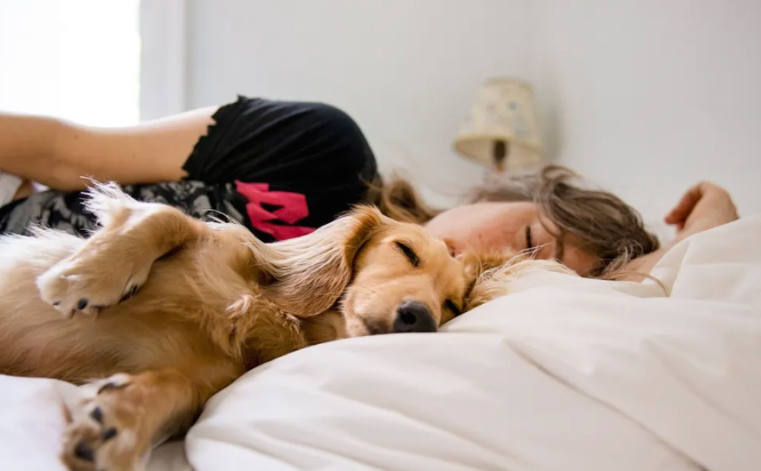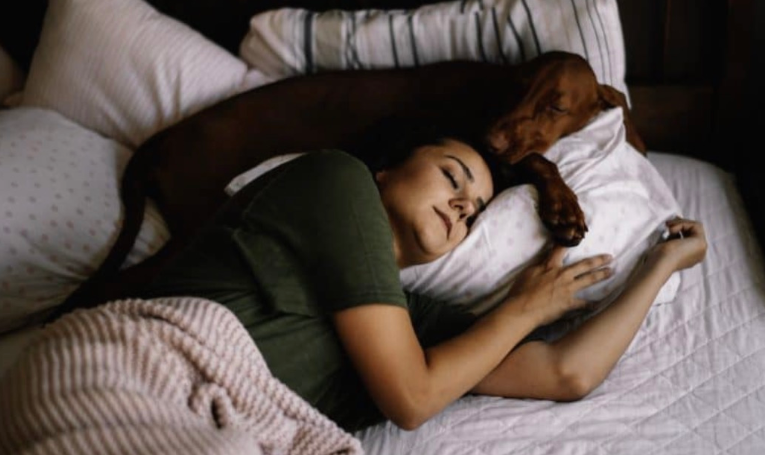
Undoubtedly, the importance of a good night’s sleep for overall health is widely acknowledged. With numerous studies exploring the optimal ways to achieve quality rest, recent research proposes a surprising solution, sharing the bed with dogs. Canisius College in New York State spearheaded this unconventional investigation, revealing that women experience better sleep next to their canine companions compared to human or feline counterparts.
Lead researcher Christy Hoffman, Ph.D., an animal behaviorist, conducted a survey involving nearly a thousand women across the United States to draw these intriguing conclusions. The results unveiled that 55% of participants shared their beds with at least one dog, 31% with a cat, and 57% with a human partner.

Hoffman delved into the reasons behind dogs emerging as superior sleep partners. The study highlighted that dogs’ sleep patterns align more closely with humans than those of cats. Hoffman theorizes that this synchronization may contribute to improved sleep quality, as dogs are adept at accommodating their owners’ sleep schedules, potentially mitigating disruptions caused by differing bedtime routines.
Furthermore, the structured routines imposed by dogs, such as morning walks, assist in regulating their owners’ daily schedules, thereby enhancing overall sleep quality. Another contributing factor is the physical stillness of dogs during sleep, unlike fidgety feline companions. Women in the study reported that dogs tended to remain on the bed throughout the night, fostering a sense of security and stability.
The study’s third crucial finding emphasizes the unique sense of security that dogs provide. Unlike cats or even human partners, dogs offer a heightened level of psychological comfort. Hoffman suggests that the perception of dogs as vigilant protectors, capable of alerting their owners to potential intruders, plays a role in enhancing the sense of security.

Despite these intriguing findings, the study acknowledges the subjectivity of sleep preferences. Factors such as a dog’s snoring or generating excess warmth could pose challenges. Additionally, there are individuals who find solace in the companionship of cats during bedtime.
It’s essential to note that the study relies on participants’ subjective perceptions of their pets’ impact on sleep quality and duration. Consequently, further research is necessary to definitively crown dogs as superior sleeping partners. Hoffman emphasizes the need for continued exploration into the various contexts under which pets positively or negatively influence sleep quality.
As American households increasingly welcome pets, understanding these dynamics becomes crucial. Future research may utilize technologies like Fitbit-like devices to objectively track sleep quality in diverse sleeping conditions, providing a more comprehensive understanding of the intricate relationship between humans and their animal companions during bedtime.
My Husband Ridiculed My Postpartum Figure at a Work Event – His Boss Confronted Him the Following Day


I’m Claire, and I’d want to talk about a moving chapter of my life that started with intense self-loathing but turned into an unforeseen path of empowerment and fresh possibilities. This metamorphosis took place both during and after a business function at my husband Tim’s boss’s opulent home. It was supposed to be a fun-filled evening, but my husband’s careless remark turned it into a significant turning point in my life.
My nerves were aroused as soon as we arrived at the lavish location by the setting’s grandeur and the guests’ exquisite clothes. I had given birth three months earlier and felt incredibly self-conscious about my postpartum physique, even though I was wearing my nicest outfit. Tim seemed especially keen to show me around his coworkers and their spouses—possibly in an attempt to win over his employer.
Inside, the energy was electric, with people having animated discussions over good wine and delicious fare. I could feel others examining me while I made an effort to socialize, which made me feel even more insecure. I was starting to get nervous that the evening would not go as planned.

In the middle of the throng, Tim and I had a quiet moment until he leaned down and said something that completely broke my calm: “Oh, God, look at their wives.” They certainly don’t tip the scales as much as you do, huh? Three months ago, you delivered birth. Why are you unable to simply resemble them?
His remarks sliced deep, and I was left reeling from the unanticipated brutality. Tears welling up in my eyes, I excused myself and ran to the safety of the restroom. I let myself cry behind the barred door, too ashamed and betrayed to stop myself.
I felt wounded and angry at the same time when I thought back on his remarks. What made him say that? Feeling completely deceived by the person who was meant to be my biggest ally, I asked questions.
Mr. Harrison, Tim’s supervisor, abruptly approached me after I had somewhat regained control. He questioned softly, “Claire, may I speak with you for a moment?” while wearing a worried expression. He spoke in a gentle tone, and I nodded, feeling shaken by the experience.



Leave a Reply